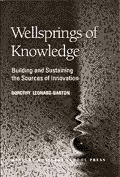"Wellsprings of Knowledge" by Dorothy Leonard-Barton
Wellsprings of Knowledge: Building and Sustaining the Sources of Innovation by Dorothy Leonard-Barton (334 pages, Harvard Business School Press, 1995)
(originally published by Booz & Company) Dorothy Leonard-Barton warns readers upfront that her new book, Wellsprings of Knowledge: Building and Sustaining the Sources of Innovation, is not a quick read. Indeed it is not, though the author, a Harvard Business School professor, tries hard to soften a knot of strategy research with true-life examples from several technology companies. Unfortunately, business books tend to be like Arnold Schwarzenegger movies: the special effects and twists are a lot more important than the basic plot, which doesn't change much.
Dorothy Leonard-Barton warns readers upfront that her new book, Wellsprings of Knowledge: Building and Sustaining the Sources of Innovation, is not a quick read. Indeed it is not, though the author, a Harvard Business School professor, tries hard to soften a knot of strategy research with true-life examples from several technology companies. Unfortunately, business books tend to be like Arnold Schwarzenegger movies: the special effects and twists are a lot more important than the basic plot, which doesn't change much.
Ms. Leonard-Barton provides a valuable survey of innovation and the barriers to innovation. In the process, she raises some perennial issues—why do designers make things without consulting their target users?—but does not significantly advance our understanding of them.
A variety of players, from Robert Reich to Newt Gingrich, have recently observed that epistemological skills are more important than technical skills, that is, that it's more important to know how to learn than to acquire particular, inevitably obsolete vocational skills.
Wellsprings of Knowledge is very à la mode in raising this attitude to an institutional level. The author views companies as sites of learning and information transfer rather than as physical or financial entities. The workforce of a forward-looking company must be able to process and manipulate knowledge as well as perform particular skills. Top management must encourage creative chaos, cross-fertilization among disciplines within the company and benchmarking with competitors. Those companies that are most enthusiastic about pursuing knowledge are those most likely to harness the power of innovation.
Because of the investment required in plants and research and development, innovation at technology companies is a high-stakes process. Consumer companies might be able to afford to miscalculate the public's desire for, say, a new and improved dish soap, but a company that chooses the wrong direction in technology, fails to keep current or responds too conservatively to obvious changes on the horizon is likely to end up expensively dead in the water.
Its core competencies, cultivated and embroidered upon, Ms. Leonard-Barton writes, are a technology company's competitive advantage. The trick for the company is to know when its core competencies become core rigidities. Several companies, like I.B.M., come in for criticism for growing too large and self-satisfied or too timid to know they would soon be in the soup. NCR, confronted with what now seems like the obvious complementarity of cash register and computer technology, went into denial and stuck with its familiar mechanical expertise. It was eventually devoured by the AT&T acquisition maw. On the other hand, the professor writes approvingly of Intel's decision to bow to inevitability and leave the memory chip business despite customer protests and the attachment of its management to the product, and focus instead on logic chips.
It's easy to see now that NCR blew an opportunity to become a leader in electronic cash register technology, just as I.B.M. proved that even a hugely profitable, too-big-to-fail behemoth can find itself on the edge of a precipice in toe shoes.
But does Ms. Leonard-Barton's approach pass the test of Ockham's razor, that is, does it use the lowest order, least complicated explanation of the phenomena in question? Arguably not. NCR would have done as well with a sharp-eyed accountant who knew that its vast inventories—all those mechanical parts—were unsustainable in the new electronic environment as with a fancily trained continuous innovation consultant.
Ms. Leonard-Barton might argue that the low status of accountants at technology companies would preclude them from delivering news of the order that the company needed to move in a technological direction with which it did not feel comfortable. That is probably true, and it highlights one especially valuable aspect of Wellsprings of Knowledge: its emphasis on behavior.
Knowledge resides in people and human relationships, a minor detail many companies forget. Late in the book, the author notes that some "empathic design" teams are beginning to employ anthropologists, who go out and observe how "users cope with unnecessarily inconvenient, uncomfortable, inefficient or inaccurate tools." That this would be considered an avant garde technique might astonish feminists, for example, who have complained for years on behalf of the housewives of America about clumsy household appliances clearly designed by men who didn't use them.
It may not be Ms. Leonard-Barton's fault that few companies have taken what seems to be an obvious step, but it reflects the basic problem with the book: there is a great deal of theoretical fuming over relatively simple ideas. ![]()



